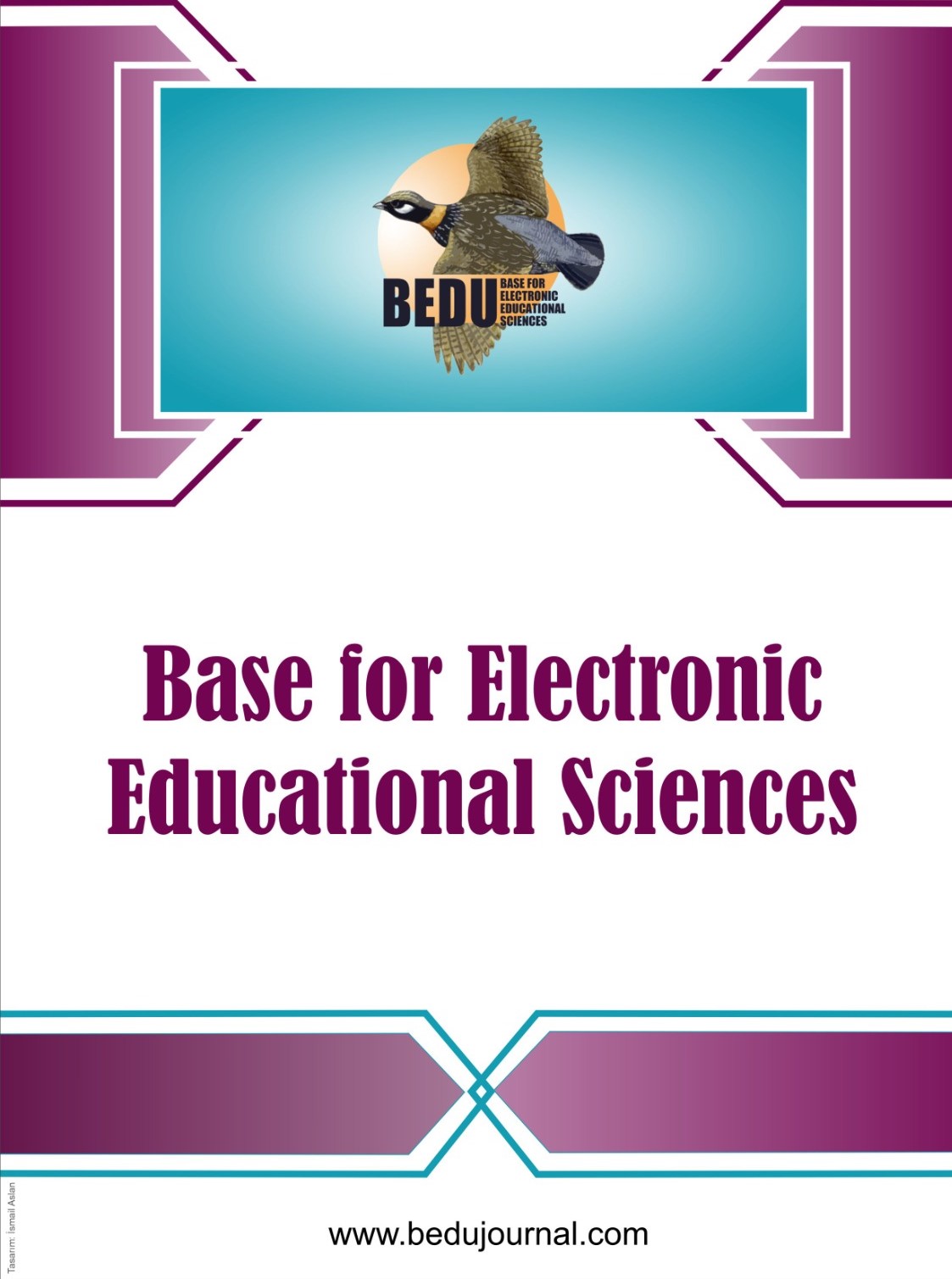Research article | Open Access
Base for Electronic Educational Sciences 2020, Vol. 1(1) 51-63
Comparison of Speaking Activities in the Coursebooks New Hitit Turkish Language for Foreigners 1 and İstanbul Turkish A1 for for Foreigners
pp. 51 - 63 | DOI: https://doi.org/10.29329/bedu.2020.253.5
Publish Date: September 17, 2020 | Single/Total View: 282/974 | Single/Total Download: 359/2.329
Abstract
Teaching Turkish as a foreign language is an increasingly important field. The number of foreigners who want to learn Turkish is increasing day by day. In foreign language teaching, four basic language skills are emphasized and teachers make various applications in the lessons to improve students' basic language skills. Textbooks are among the resources used in foreign language teaching. Activities prepared in accordance with the principles of each level can speed up students language learning processes. In addition, the use of various visuals in the activities in the textbooks can intensify the students attention, making it easier to understand abstract concepts. Speech, one of the four basic language skills, is a skill that exists in every moment of human life. While learning a foreign language, as in their mother tongue, people provide their communication with speaking skills. Students who improve their speaking skills can express themselves more effectively, increase their self-confidence and communicate comfortably with their environment. In this study, the speaking activities of the Turkish textbook 1 for New Hitit Foreigners and the Turkish A1 textbook for Istanbul Foreigners were compared. It was emphasized whether visuals were used in the speech activities examined, whether the activities developed other skills as well. In addition, the appropriateness of the activities to those measured for the A1 level speech assessment in the European Common Reference for Languages text was examined. It is hoped that the suggestions made based on the findings reached by comparing the speech activities in both books will contribute to the new speech activities.
Keywords: Turkish for foreigners, Speech activities, Comparison, Istanbul, New Hitit, Textbook.
APA 7th edition
Tanrikulu, L., & Oncul, E. (2020). Comparison of Speaking Activities in the Coursebooks New Hitit Turkish Language for Foreigners 1 and İstanbul Turkish A1 for for Foreigners. Base for Electronic Educational Sciences, 1(1), 51-63. https://doi.org/10.29329/bedu.2020.253.5
Harvard
Tanrikulu, L. and Oncul, E. (2020). Comparison of Speaking Activities in the Coursebooks New Hitit Turkish Language for Foreigners 1 and İstanbul Turkish A1 for for Foreigners. Base for Electronic Educational Sciences, 1(1), pp. 51-63.
Chicago 16th edition
Tanrikulu, Lokman and Esat Oncul (2020). "Comparison of Speaking Activities in the Coursebooks New Hitit Turkish Language for Foreigners 1 and İstanbul Turkish A1 for for Foreigners". Base for Electronic Educational Sciences 1 (1):51-63. https://doi.org/10.29329/bedu.2020.253.5
Akcan, S. (2014). Speaking education. D. Yaylı ve Y. Bayyurt. (Ed.) In Teaching Turkish to foreigners, policies, methods and skills (s. 202-210). Ankara: Anı Publishing.
Arı, G. (2018). Speaking education. M. Durmuş ve A. Okur (Ed.) In Turkish Teaching Handbook for Foreigners içinde (s. 277-293). Ankara: Grafiker Publishing.
Boylu, E. & Çangal, Ö. (2015). Turkish as a foreign language learner students in bosnia and herzegovina speaking anxiety investigation of different variables. International Journal of Turkish Literature Culture Education (TLCE), (4)1, 349-368.
Doğan, A. (1973). Lise öğrencilerinin İngilizce öğrenimlerini etkileyen yabancı dil kaygısı [Foreign language anxiety affecting high school students' English learning]. Dil Dergisi [Language Journal], 139, 48-67.
Durmuş, M. (2013). Yabancılara Türkçe öğretimi [Teaching Turkish to foreigners]. Ankara: Grafiker Publishing.
Göçer, A. (2009). Activities of developing vocabulary of students and dictionary usage in Turkish education. Turkish Studies, (4)4, 1025-1055. http://dx.doi.org/10.7827/TurkishStudies.1318
Göçer, A. (2015). Improvement of speaking skills in teaching Turkish as a foreign language. Trakya University Journal of Social Sciences, 17(2), 21-36.
Göçer, A. & Moğul, S. (2011). A general persrective on the studies in accordance with the teaching Turkish as a foreign language. Turkish Studies, (6)3, 797-810. http://dx.doi.org/10.7827/TurkishStudies.2470
Güneş, F. (2014). Turkish teaching approaches and models. Ankara: PegemA Publishing.
Güzel, A. & Barın, E. (2013). Teaching Turkish as a foreign language. Ankara: Akçağ Publishing.
Hattatioğlu, A. (2019). Comparison of foreign language teaching books for Turkish, English and German in terms of speaking activities. (Unpublished Master Thesis). Hacettepe University Institute of Educational Sciences, Ankara.
İşci, C. (2012). The evalaution of the effectiveness of the textbook Yeni Hitit used in teaching Turkish as a foreing language in terms of the four basic language skills and culture. (Unpublished Master Thesis). Dokuz Eylül University Institute of Educational Sciences, İzmir.
Köksal, D. & Pestil, D. (2014) Yabancı dil olarak Türkçe konuşma öğretimi içinde. A. Şahin (ed.) Yabancı dil olarak Türkçe öğretimi kuramlar, yaklaşımlar, etkinlikler (s. 295-316). Ankara: PegemA Publishing.
Kurudayıoğlu, M. (2003). Konuşma eğitimi ve konuşma becerisini geliştirmeye yönelik etklinlikler [Speech training and speaking skills activities for development]. Journal of Turkology Research, 13, 287-309.
Metin, M. (2015). Kuramdan uygulamaya eğitimde bilimsel araştırma yöntemleri [Scientific research methods in education from theory to practice]. Ankara: PegemA Publishing.
Oğuzkan, F. (2001). Çocuk edebiyatı [Children's literature]. Ankara: Anı Publishing.
Öz, F. M. (2011). Uygulamalı Türkçe öğretimi [Applied Turkish teaching]. Ankara: Anı Publishing.
Sallabaş, M.E. (2012). An evaluation of speaking anxiety for learners of Turkish as a foreign language. Turkish Studies, 7(3), 2119-2218. http://dx.doi.org/10.7827/TurkishStudies.3481
Sever, S. (2015). Türkçe öğretimi ve tam öğrenme [Turkish teaching and full learning]. Ankara: Anı Publishing.
Şen, Ü. & Boylu, E. (2015). Evaluation of speaking anxiety of iranian learners learning turkish as foreign language. Mustafa Kemal University Journal of Graduate School of Social Sciences, 12(30), 13-25.
Tanju, B. (2019). Suggested communicative speaking activities for A1 and A2 level classes in teaching Turkish as a foreign language. (Unpublished Master Thesis). İstanbul University Institute of Social Sciences, İstanbul.
Yılmaz, M. & Taşkaya, S. M. (2014). Yeni gelişmeler işığında Türkçe öğretimi [Teaching Turkish in the light of new developments]. Ankara: PegemA Publishing.
